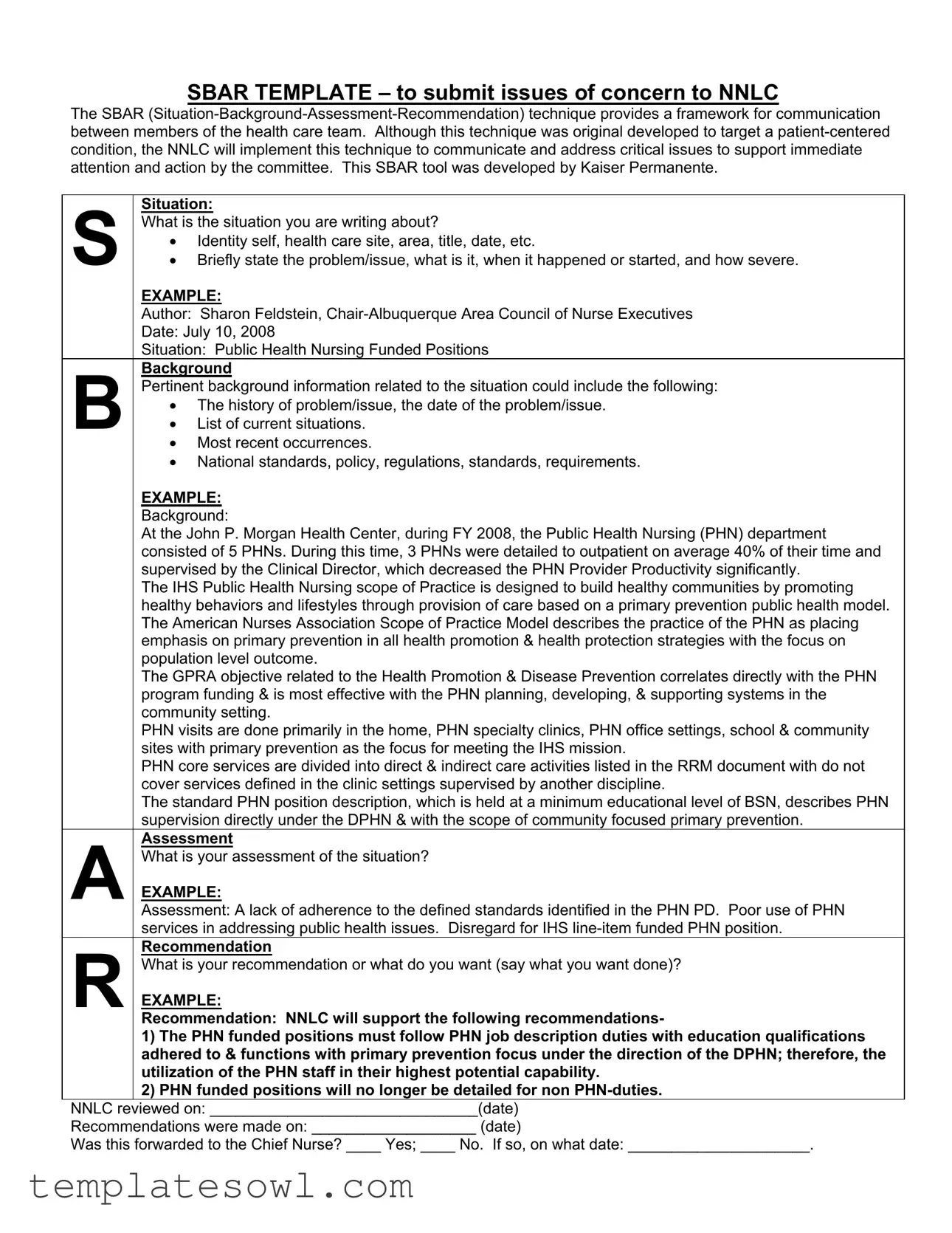SBAR TEMPLATE – to submit issues of concern to NNLC
The SBAR (Situation-Background-Assessment-Recommendation) technique provides a framework for communication between members of the health care team. Although this technique was original developed to target a patient-centered condition, the NNLC will implement this technique to communicate and address critical issues to support immediate attention and action by the committee. This SBAR tool was developed by Kaiser Permanente.
Situation:
SWhat is the situation you are writing about?
•Identity self, health care site, area, title, date, etc.
•Briefly state the problem/issue, what is it, when it happened or started, and how severe.
EXAMPLE:
Author: Sharon Feldstein, Chair-Albuquerque Area Council of Nurse Executives
Date: July 10, 2008
Situation: Public Health Nursing Funded Positions
Background
BPertinent background information related to the situation could include the following:
•The history of problem/issue, the date of the problem/issue.
•List of current situations.
•Most recent occurrences.
•National standards, policy, regulations, standards, requirements.
EXAMPLE:
Background:
At the John P. Morgan Health Center, during FY 2008, the Public Health Nursing (PHN) department consisted of 5 PHNs. During this time, 3 PHNs were detailed to outpatient on average 40% of their time and supervised by the Clinical Director, which decreased the PHN Provider Productivity significantly.
The IHS Public Health Nursing scope of Practice is designed to build healthy communities by promoting healthy behaviors and lifestyles through provision of care based on a primary prevention public health model. The American Nurses Association Scope of Practice Model describes the practice of the PHN as placing emphasis on primary prevention in all health promotion & health protection strategies with the focus on population level outcome.
The GPRA objective related to the Health Promotion & Disease Prevention correlates directly with the PHN program funding & is most effective with the PHN planning, developing, & supporting systems in the community setting.
PHN visits are done primarily in the home, PHN specialty clinics, PHN office settings, school & community sites with primary prevention as the focus for meeting the IHS mission.
PHN core services are divided into direct & indirect care activities listed in the RRM document with do not cover services defined in the clinic settings supervised by another discipline.
The standard PHN position description, which is held at a minimum educational level of BSN, describes PHN supervision directly under the DPHN & with the scope of community focused primary prevention.
Assessment
AWhat is your assessment of the situation?
EXAMPLE:
Assessment: A lack of adherence to the defined standards identified in the PHN PD. Poor use of PHN services in addressing public health issues. Disregard for IHS line-item funded PHN position.
Recommendation
RWhat is your recommendation or what do you want (say what you want done)?
EXAMPLE:
Recommendation: NNLC will support the following recommendations-
1)The PHN funded positions must follow PHN job description duties with education qualifications adhered to & functions with primary prevention focus under the direction of the DPHN; therefore, the utilization of the PHN staff in their highest potential capability.
2)PHN funded positions will no longer be detailed for non PHN-duties.
NNLC reviewed on: _______________________________(date)
Recommendations were made on: ___________________ (date)
Was this forwarded to the Chief Nurse? ____ Yes; ____ No. If so, on what date: _____________________.

